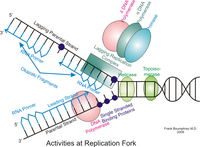
Photo from wikipedia
Chemotaxis, the motion of cells directed by a gradient of chemoattractant molecules, guides cells in immune response, development, wound healing, and cancer. Unfortunately, this process is difficult to distinguish from… Click to show full abstract
Chemotaxis, the motion of cells directed by a gradient of chemoattractant molecules, guides cells in immune response, development, wound healing, and cancer. Unfortunately, this process is difficult to distinguish from chemokinesis, i.e., stimulated random cell motion. Chemotaxis is frequently inferred by determining how many cells cross a boundary in a chemotaxis assay, for example how many cells crawl into a chemoattractant-infused filter, or how many cells enter a defined region in an under-agarose assay or agarose spot assay. To mitigate possible ambiguity in whether motion observed in these assays is directed by the chemoattractant gradient or by chemokinesis, we developed a mathematical model to determine when such methods indeed indicate directed motion of cells. In contrast to previous analyses of chemotaxis assays, we report not just the gradients that arise in the assays but also resulting cell motion. We applied the model to data obtained from rigorous measurements and show, as examples, that MDA-MB-231 breast-cancer cells are at least 20 times less sensitive to gradients of EGF or CXCL12 than neutrophils are to formyl peptides; we then used this information to determine the extent to which gradient sensing increases the rate of boundary crossing relative to a random-motility control. Results show, for example, that in the filter assay, 2-4 times as many neutrophils pass through the filter when exposed to a gradient as when the gradient is absent. However, in the other combinations of cells and assays we considered, only 10-20% more cells are counted as having migrated in a directed, rather than random, motility condition. We also discuss the design of appropriate controls for these assays, which is difficult for the under-agarose and agarose spot assays. Moreover, although straightforward to perform with the filter assay, reliable controls are often not done. Consequently, we infer that chemotaxis is frequently over-reported, especially for cells like MDA-MB-231 cells, which move slowly and are relatively insensitive to gradients. Such results provide insights into the use of chemotaxis assays, particularly if one wants to acquire and analyze quantitative data.
Journal Title: Journal of theoretical biology
Year Published: 2017
Link to full text (if available)
Share on Social Media: Sign Up to like & get
recommendations!